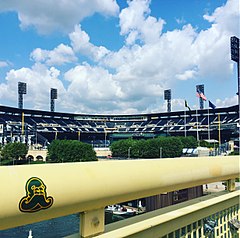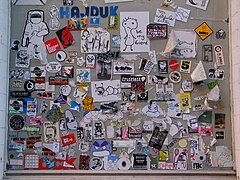
Graffiti is art that is written, painted or drawn on a wall or other surface, usually without permission and within public view. Graffiti ranges from simple written words to elaborate wall paintings, and has existed since ancient times, with examples dating back to ancient Egypt, ancient Greece, and the Roman Empire.

Fred Brathwaite, more popularly known as Fab 5 Freddy, is an American visual artist, filmmaker, and hip hop pioneer. He is considered one of the architects of the street art movement. Freddy emerged in New York's downtown underground creative scene in the late 1970s as a graffiti artist. He was the bridge between the burgeoning uptown rap scene and the downtown No Wave art scene. He gained wider recognition in 1981 when Debbie Harry rapped on the Blondie song "Rapture" that "Fab 5 Freddy told me everybody's fly." In the late 1980s, Freddy became the first host of the groundbreaking hip-hop music video show Yo! MTV Raps.

Wildstyle is a complicated and intricate form of graffiti. They are the most complex type of pieces. Due to its complexity, wildstyle can be difficult to read for those unfamiliar with the form and process. It is considered the most difficult graffiti style to master.

Revs is a New York City graffiti artist whose wheat paste stickers, roller pieces, murals, sculptures, and spray-painted diary entries earned him the reputation of an artist-provocateur over the course of two decades. "Revs" is his tag name; his real name is unknown. Before adopting the tag name "Revs" he had used the tag name "Revlon". in a 1993 New York Times interview he said he decided to shorten it to "Revs" following an epiphany he experienced after contemplating suicide on the Manhattan Bridge.

Street art is visual art created in public locations for public visibility. It has been associated with the terms "independent art", "post-graffiti", "neo-graffiti" and guerrilla art.
The Bubble Project, as proclaimed by its manifesto, aims to counteract corporate marketing and advertisement messages in public spaces.

Stencil graffiti is a form of graffiti that makes use of stencils made out of paper, cardboard, or other media to create an image or text that is easily reproducible. The desired design is cut out of the selected medium and then the image is transferred to a surface through the use of spray paint or roll-on paint.
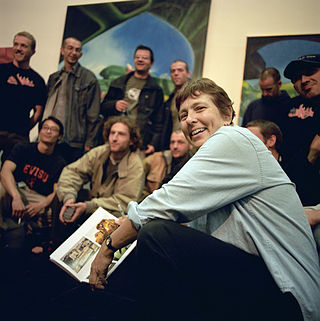
Martha Cooper is an American photojournalist. She worked as a staff photographer for the New York Post during the 1970s. She is best known for documenting the New York City graffiti scene of the 1970s and 1980s.
James Dodd is a South Australian artist, arts educator and street artist who used the pseudonym Dlux for his street art when he operated out of Melbourne.
Meek is a notable street artist operating out of Melbourne, Australia, and specialising in the subgenre of stencil graffiti.

Dean Stockton, better known by his alias D*Face, is an English multimedia street artist who uses spray paint, stickers, posters, and stencils.
Melbourne, the capital of Victoria and the second largest city in Australia, has gained international acclaim for its diverse range of street art and associated subcultures. Throughout the 1970s and 1980s, much of the city's disaffected youth were influenced by the graffiti of New York City, which subsequently became popular in Melbourne's inner suburbs, and along suburban railway and tram lines.
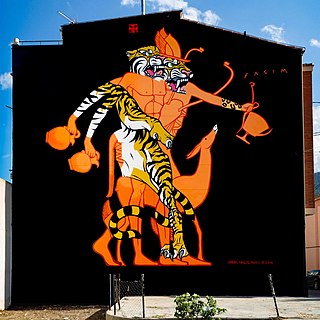
Urban art combines street art and graffiti and is often used to summarize all visual art forms arising in urban areas, being inspired by urban architecture or present urban lifestyle. Because the urban arts are characterized by existing in the public space, they are often viewed as vandalism and destruction of private property.
RISK, also known as RISKY, is a Los Angeles–based graffiti writer and contemporary artist often credited as a founder of the West Coast graffiti scene. In the 1980s, he was one of the first graffiti writers in Southern California to paint freight trains, and he pioneered writing on "heavens", or freeway overpasses. He took his graffiti into the gallery with the launch of the Third Rail series of art shows, and later created a line of graffiti-inspired clothing. In 2017, RISK was knighted by the Medici Family.

Label 228 is a sticker issued by the United States Postal Service for labeling Priority Mail packages with a mailing address. Label 228 is available free of charge at all USPS Post Office locations or delivered by mail when ordered online.
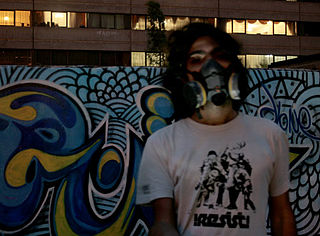
A1one is the pseudonym of Karan Reshad, an Iranian visual artist who pioneered graffiti and street art in Iran. His career as a street artist began in his hometown Tehran.
Roger Gastman is an American art dealer, curator, filmmaker, and publisher who focuses on graffiti and street art.

West Bank Wall graffiti art is street art on the walled sections of the Israeli West Bank barrier, by a wide range of international and Palestinian artists. The wall is 8 to 10 metres tall, and is easily accessible to artists as it frequently divides urban areas. The graffiti is on the Palestinian side of the wall and primarily expresses anti-wall sentiments.

Tags are one of the primary forms of graffiti, along with throw ups and pieces. The act of writing a tag is known as tagging. Tags are often thought of as the simplest form of graffiti art, prioritising legibility and flow and are the form that most artists start with. Tags, perhaps due to their simplicity, are more likely to be considered vandalism than other more elaborate graffiti styles.

Pieces, short for masterpieces, are a form of graffiti that involves large, elaborate and detailed letter forms. They are one of the main forms of modern graffiti, along with tags and throw ups, and are the least controversial of the three and least likely to be seen as vandalism.

